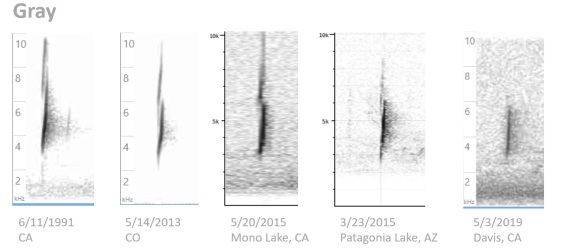After a flurry of migrant Empidonax flycatchers this April in California, a number of us engaged in a discussion about their whit! call notes. Specifically, could we tell Willow from Dusky from Gray just by the whit? Personally, I’m not there yet. I usually only hear them a few times a year, which is insufficient experience, and I suspect there’s individual variation as well as the tricks that wind, humidity, and distance play on sound. But what about analyzing their sonograms with a good recording?
I looked at the very best on-line recordings from the Macaulay Library (collected via eBird, and there’s a collection of the best ones at Peterson Bird Sounds) and from xeno-canto. (Warning: the horizontal axis is different between their sonograms. Xeno-canto sonograms fit about two seconds in the space where Macaulay fits one second of recording, thus compressing the sonogram. Here, I stretched the xeno-canto sonograms horizontally to adjust for that.)
It appears that Willow, with a good recording, is distinctive, with up to three harmonic tones and that downward slope after the upward slow. To the ear, the Willow whit is softer and sweeter than the others. Dusky and Gray, on the other hand, are both dry sharp whits, and virtually indistinguishable on the sonograms. Gray is more likely to go up to 10 kHz or higher, and that echo line on the first Gray sonogram was consistent on all the calls, at least for that individual recording. For the record, Least was similar to Dusky and Gray, although the triangular dark shadow to the right of the main call tended to be thicker and larger.

iPhone recording
To the right is a typical iPhone recording, probably a Dusky. Based only on this sonogram, just a shadow of the good ones above, it could be any of the species. The take-home lesson is that one could probably diagnostically identify a Willow whit from a sonogram with a very good recording. The Dusky and Gray whits are too close to call.
Our discussion also focused on spring migration timing and incorporated Hammond’s (as many of these birds are silent). Again, I turned to eBird for some trends.
CLICK TO ENLARGE

Spring migration for western Empids. These maps are based on 2017-18 data. I excluded a few outliers in each case. Nevertheless, these dates represent the earliest arrivals. Most birds were a week later than the dates shown.
The results are that Hammond’s is the earliest, followed by Gray and then Dusky. For all three, however, there was a pulse of records during the last week of April. Willow is a full month behind the other two. In fact, even in southern Arizona there were very few Willow records before May 10.
 Much has been written about Empid identification. Here’s a link to the Rowland 2009 article in Birding. My personal favorite is the chapter in Kenn Kaufmann’s Advanced Birding. The diagram at left is from the old version; the new one is even better, showing variations within species.
Much has been written about Empid identification. Here’s a link to the Rowland 2009 article in Birding. My personal favorite is the chapter in Kenn Kaufmann’s Advanced Birding. The diagram at left is from the old version; the new one is even better, showing variations within species.
For the Hammond’s/Dusky challenge in spring, I put together the diagram below. These identifications were confirmed by calling birds, which are easily separated (Hammond’s says peep rather than whit).
Finally, if you’re still confused, there’s this infamous meme:





